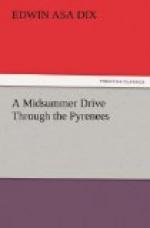The wealthy French and Spanish, who are the chief visitors to these resorts, are judicious travelers; they injure neither the dispositions nor the independence of the natives. The Anglo-Saxon will come in time; he will regard these natives, as everywhere, as a lesser humanity; he will throw them centimes and sous; he will find imperious fault; he will cut off this ready communicativeness, miss all touch with these friendly lives, and knock their confiding “feelers” back into the shell. But the advance-guard at least of our countrymen will find here a human nature poor and narrowed but right-minded, true, unwarped either by feudal lordliness or modern superciliousness. Reciprocity of treatment, let us hope, will endeavor to keep it so for years yet coming.
IV.
There is a famous old church of the Templars at Luz, which we go to see. It stands at the top of a hilly street, shut off behind a stout fortified wall and between two square flanking towers. We pass through the gateway, and the old sacristan lets us into the church. There is a curious gate, a turret rough in traced carving, and inside, in the dim light, we are chiefly impressed with the rude-gilded altar and the grotesque frescoes on the walls. Yet there is a certain solemnity about the darkness and stillness, after coming from the warm daylight outside. It preaches silently of devotion, of the mystery of religion, of the power and the poetry of worship. “It is a superstition of the place that at a certain time the dead warrior-priests rise from their graves and sit in ghostly assembly, remembering the time when they had raised these rafters and piled these stones together and worshiped therein and died and were buried beneath them.
“The old church lies in the shadow of the Pic de Bergonz and within ear-shot of a mountain’s torrent; and the moonlight plays all sorts of fantastic tricks, throwing strange shadows, until it is not difficult to fancy that unearthly forms are near.... At the hour of vespers, there are as many as two hundred women in the church, [their heads always covered with their brown or scarlet capulets,] and its ancient, sombre interior appears filled with hooded figures, such as have often troubled our childish dreams, kneeling and crouching in the uncertain twilight to the sound of the Miserere."[26]
No one knows the age of this church. Some accounts give the year 1060, but as the Templars’ order was not founded until 1117 or 1118, this is improbable. They were warlike in their religion, these Templars, quite as able to fight as to pray, pledged “never to fly before three infidels even when alone,” and with a stirring touch of romance about all their history. They were planted here, as is stated, to guard the frontier in those troublous times, keeping vigilant watch against both Saracens and Spaniards; and few will say that the Christian valley of Luz could have been more efficiently defended.




